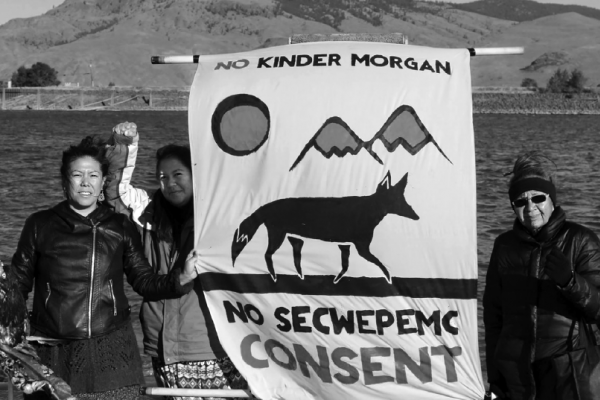The Two Bolivias Square Off
With the embers of the “Gas War” of 2003 still glowing, the failure of the government to respond to protestors’ demands has fanned new flames of indignation, reaction and counter-reaction throughout Bolivia in recent weeks. The country has become increasingly polarized as the Right and the Left radicalize their respective agendas.
The key issue concerns control over the country’s natural resources–particularly gas. Bolivia is home to the second-largest natural-gas deposits in Latin America, which mostly lie in the eastern and southern regions of the country. This area is also home to some of the most powerful elements of Bolivia’s capitalist class–agro-exporters and gas magnates–who are reticent to give up their privileged position in regard to the state and their monopoly of land and resources.
Over the month of September, 2003, blockades, hunger strikes and marches took place primarily in the Aymara-indigenous high plains (altiplano) of the Department of La Paz. Peasants organized around a series of issues related to gaining control over their communities and an end to the neoliberal ravaging of the agricultural economy that began in 1985. As the month wore on, and as the resistance tactics continued, the response of then-president Gonzalo (Goni) Sánchez de Lozada was to increase repression, most infamously in the case of the massacre in the pueblo of Warisata. In response, the indigenous peasantry mobilized further, as did the miners from Oruro, and other sectors of the altiplano.
The mobilizations that arose first in the countryside quickly flowed into El Alto, which overlooks the valley in which the capital, La Paz, is located. It is a massive shantytown of recent ruralurban migrants and “relocated” miners. With persistent cultural and familial relations between the urban residents of El Alto and the surrounding countryside, the gradual urban expression of the altiplano’s discontent was a natural progression.
The October Agenda
Through a complicated set of conjunctural and historical factors, by October, 2003, the theme of nationalizing natural gas became the central unifying factor of the mobilized social movements in the countryside, the mines, El Alto and, eventually, La Paz and throughout the country. The other catalyst, of course, was the demand that Goni resign after his repressive manoeuvres against indigenous civilians.
After days and weeks of general strikes, marches, blockades and, eventually, generalized insurrection in the city of El Alto, Goni launched a military assault against the rebels. Against this indiscriminate killing through the machinery of the state, the insurrection of October generalized and many residents (mostly from the lower-class areas) of La Paz joined the rebellion. By October 17, 2003, 500,000 people were mobilized in the streets of La Paz, and Goni and the closest members of his crew fled to the United States, where they remain in exile. Over 60 were dead, but the streets were filled with joy at the successful removal of the hated president. Carlos Mesa, vice president under the Goni regime, distanced himself publicly from the president during the worst days of massacring and effectively rode the wave of insurrection to the presidency with a promise to implement the people’s demands.
These themes of struggle came to be known as the “October Agenda,” which still threatens to upset the pyramidal structure of Bolivia in which a tiny elite controls the lion’s share of resources, while the vast majority of Bolivians, mostly indigenous, live in poverty. In particular, two central demands of the October Agenda, the nationalization of hydrocarbon resources and the creation of a “Constituent Assembly,” promise deep political reforms and radical redistribution of the productive resources of the country.
The Second Water War
Up until now, however, little progress has been made, leading to mounting tension amongst different social sectors. The current wave of protests started in early January of this year, with Bolivia’s “Second Water War,” when citizens of El Alto took to the streets with a series of demands, including the expulsion of a private water company, Aguas del Illimani, a consortium headed by French multinational Suez, and its replacement with a new public water company under democratic social control. Just as this conflict in El Alto subsided with the government promising to cancel Aguas del Illimani’s contract, up to 300,000 people took to the streets in Santa Cruz aiming to take back control of the agenda. In early March, protests and road blockades erupted again–this time organized by indigenous peasant and cocalero (coca-grower) movements pressing for a new hydrocarbons law–which blocked transit between seven of the nine regions of the country.
With the Left effectively shutting down the country, and the far Right of Santa Cruz demanding the end of blockades through whatever means necessary, President Mesa opted to abandon his soft-Right alliance that depended on the support of Evo Morales and his Movement Toward Socialism (MAS), and instead turned to the traditional parties of the Right in an effort to construct a new anti-popular coalition.
Mesa’s New Mandate from the Right
In what has to be one of the most ahistorical, manipulative speeches made by an ex-historian, Bolivia’s President Carlos Mesa Gisbert announced his resignation on Sunday, March 6.
Mesa’s performance that Sunday evening is instructive in many ways. First, the enemies of state were clearly defined. Evo Morales of MAS, currently the most popular political party in the country, was described as an obstructionist, special-interest troublemaker who understands neither democracy nor international economics. Abel Mamani of the Federation of Neighbourhood Committees of El Alto (FEJUVE-El Alto), a central protagonist in the “Second Water War”), was painted in the same light. Publically identifying the protagonists of the Left and the supporters of strikes and road blockades is obviously meant to lay the groundwork for marginalization through repression. While Mesa hasn’t yet begun repression in earnest, the social forces behind his new coalition–the business elite and much of the middle class–are chomping at the bit to clear the blockaded roadways of the country, while sweeping clear from the present political conjuncture any possibility of the October Agenda, as well.
Second, Mesa’s speech to Bolivians clarified to what constituency he responds and how he defines “democracy.” In response to MAS’s proposed hydrocarbons law–one that would effectively distribute more of the wealth generated from natural resources to the country’s impoverished majority and away from transnational gas companies–Mesa complained, “Brazil has told us, Spain has told us, the World Bank, the United States, the International Monetary Fund, Great Britain, and all of the European Union: Bolivians, approve a law that is viable and acceptable to the international community,” not one that responds to Bolivia’s social and economic interests! In response to FEJUVE-El Alto’s demand for the immediate exit of the transnational company, Suez, Mesa threatened that Bolivians would have to pay U.S. $17 million to the World Bank, which owns eight per cent of Aguas del Illimani shares through its private lending arm, the International Finance Corporation. Both the Bank and Mesa have made it clear that private participation in the new company is a condition to receive new loans.
A crowd of several thousand middle-class Paceños (residents of La Paz) quickly gathered outside the Presidential Palace in the Plaza Murillo demanding that the president stay in office and begin to use a “mano dura” (iron fist) against the social movements that had effectively shut down the country. Cries from the crowd included “Death to Evo!” and “Evo and Abel are the Apocalypse!”
In phrases eerily reminiscent of those of ex-president Goni in the lead-up to the massacre of civilian protesters in October, 2003, Mesa began emphasizing the state’s responsibility to protect the “human rights” of those Bolivians who want to work against those who are shutting down the country for sectoral demands that are impossible to meet within the framework of an austere budget and the strictures of the “international community.” The national police and armed forces were put on alert and mobilized in various areas.
Throughout his speech, Mesa sought a mandate to use force against the movements pushing for the October Agenda. What he failed to mention is that he became president thanks to the mobilization of October, whose social base allowed him to stay contingent upon his promise to meet the popular demands.
With the benefit of hindsight, Mesa’s political acumen has been extraordinary. He presented his resignation to Congress, but it was obvious by Monday that the resignation was not irrevocable and that he would be willing to stay if the conditions were right. Just as he wanted, all the traditional parties of the Right coalesced and begged him to stay in office with a new mandate to crush the social movements, while MAS and the Indigenous Pachakuti Movement (MIP) were isolated in Congress, portrayed as the intransigent, irrelevant Left. Politics in Bolivia, however, is rarely determined in the hallowed halls of the legislature. The Left’s potential has always been in the streets.
Uniting the Left
Only time will tell whether Mesa’s tactic has succeeded, but it has inspired a rare moment in Bolivian politics–the uniting of progressive social movements that have historically fought one another as much as the enemies they hold in common. In a pact–signed by Evo Morales, Jaime Solares (leader of the Bolivian Workers’ Central, the COB), Felipe Quispe and Román Loayza (leaders of the campesino union, the CSUTCB), Roberto de la Cruz (councillor of El Alto, who played a central role in the October rebellion), Alejo Véliz (leader of the Trópico de Cochabamba, an association of coca-growers), leaders of the Bolivian Movimiento Sin Tierra landless movement, Oscar Olivera (from the Coordinador of Water and Gas), Omar Fernandez (from the irrigating farmers’ association in Cochabamba), among others–major social leaders from all over the country made a commitment to co-ordinate efforts in the fight against President Mesa and the neoliberal parties that defend transnational corporations, the mining companies and privatized enterprises. As journalist Luis Gomez notes, it is rare to find these leaders of the Left in the same room together, never mind united behind a common agenda.
Some of the most radical social-movement leaders, like Jaime Solares, who up until recently have demanded the outright nationalization of the hydrocarbon industry, are moving towards MAS’s more moderate proposal–a law that would require transnational gas companies to pay the state 50 per cent in royalties–in an effort to defeat the current proposal in Congress, which stipulates only 32-per-cent royalties and 18-per-cent taxes (taxes, in contrast to royalties, are more amenable to manipulation and reduction in the future).
While there is reason to hope that a united Left can win the struggle for more control over gas–commonly referred to as the “last hope” for national development–there are important leaders who are notably absent from the pact. Abel Mamani appears to be keeping his distance from the coalition in order to focus on more local issues, which reflects FEJUVE’s historical fear of inserting itself directly in traditional party “politics.” MAS is also far from united in its support for the social movements. Some deputies of paler complexion within the party are publicly criticizing Evo Morales’ move towards the base for fears of how it will alienate more moderate supporters and affect the party’s performance in the next presidential elections.
Susan Spronk is a Ph.D. candidate in political science at York University in Toronto.
Jeffery R. Webber is a Ph.D. candidate in political science at the University of Toronto, and a member of the Canadian New Socialist Group. Both are currently in La Paz.
The authors would like to thank Cy Gonick and Juan Arbona for helpful comments.
This article appeared in the May/June 2005 issue of Canadian Dimension .










